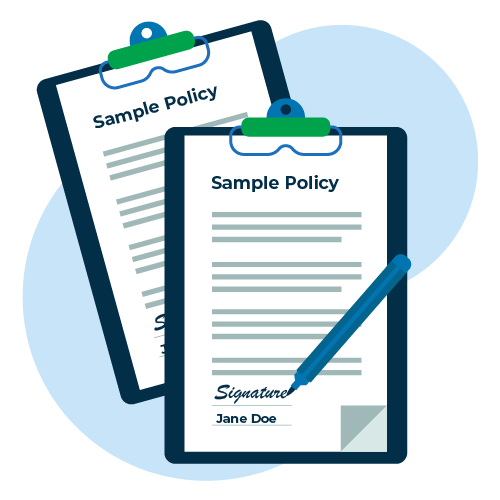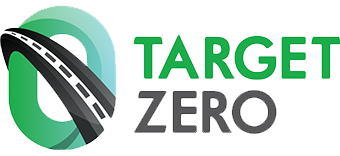STEP 2
Tool 2G
Sample Policies

DISCLAIMER: The policies provided are examples. They should not be interpreted as legal advice for your workplace. All policies should be created with your unique workplace in mind and reviewed by your own policy advisors or legal counsel.
Draft Sample Policy
This policy is intended to reduce the risk of distracted driving crashes while using state-issued personal electronic devices or driving state vehicles, and to clarify expectations that employees should focus on driving, not working, when they are behind the wheel.
Definitions
Driving — To operate a motor vehicle on a public roadway, including while temporarily stationary because of traffic, traffic control device, or other momentary delays. “Driving” does not include when the driver has pulled the vehicle over to the side of, or off, an active roadway and has stopped in a location where the vehicle can safely remain stationary.
Hand-held or hands-free cell phone use — (1) Talking on a cell phone. (2) Using your hand or finger to compose, send, read, view, access, browse, transmit, save, or retrieve email, text messages, instant messages, photographs, or other electronic data. (3) Watching video. (4) Listening to podcasts/music.
Personal electronic device – Any portable electronic device that is capable of wireless communication or electronic data retrieval and is not manufactured primarily for handsfree use in a motor vehicle. “Personal electronic device” includes, but is not limited to, a cell phone, tablet, laptop, two-way messaging device, or electronic game.
It is the policy of the WTSC to promote employee safety; therefore, when conducting state business, employees shall not use hand-held or hands-free personal electronic devices while driving – whether the vehicle is in motion or stopped in traffic. This applies whether the employee is using a state vehicle or a privately-owned vehicle and whether the employee is using a state-issued or personally-owned electronic device.
Employees shall ensure that secondary tasks, such as eating, drinking, or grooming do not cause unsafe driving.
The WTSC does not require or expect employees to conduct work while driving. This includes responding to or initiating messages, e-mails, or phone calls, or participating on conference calls.
While driving on work-related business, employees are expected to focus their full attention on the task of driving.
All hand-held or hands-free personal electronic device use is prohibited, except that an employee may use navigation, music, or other non-interactive apps as long as the use of these apps is initiated or updated while the vehicle is parked.
If a driver needs to use their electronic device, they must pull over to the side of, or off, an active roadway and to a location where the vehicle can safely remain stationary. The shoulder of the freeway is not considered a safe location.
Electronic signature by each employee is required.
Draft Sample Policy
Because [Insert COMPANY NAME] is committed to establishing and following practices that make working here safer, and because we value the safety and well-being of all employees of [insert COMPANY NAME], we are instituting a distraction-free driving policy to promote safe driving habits.
[insert COMPANY NAME] employees must refrain from using mobile phones and other mobile devices, either hand-held or hands-free, while operating a motor vehicle.
[Insert COMPANY NAME] employees must not initiate or respond to phone calls or read or respond to text messages or emails while driving a passenger or commercial vehicle.
[Insert COMPANY NAME] employees who need to make a call while on the road must first park the vehicle in a safe location.
Failure to follow company policy and refrain from talking on the phone, texting, or emailing while driving on or off the job may result in [insert CONSEQUENCES WHICH YOU DEEM APPROPRIATE, SUCH AS VERBAL WARNING, WRITTEN WARNING, DISMISSAL, OTHER].
MOTOR VEHICLE SAFETY POLICY ACKNOWLEDGEMENT
I have received a written copy of [insert COMPANY NAME]’s distraction-free driving policy. I fully understand the terms of this policy and agree to abide by them. Sign and print your name, add today’s date, and return this form to your supervisor.
_________________________________________ ______________________
Employee Signature Date
_________________________________________
Employee Name (printed)
Thank you for practicing safe driving habits.
National Highway Traffic Safety Administration (NHTSA)
[Company Name] Distracted Driving Policy
Please read the Distracted Driving Policy, sign, and return to your supervisor.
In order to increase employee safety and eliminate unnecessary risks behind the wheel, [Company Name] has enacted a Distracted Driving Policy, effective [Date]. We are committed to ending the epidemic of distracted driving, and have created the following rules, which apply to any employee operating a company vehicle or using a company-issued cell phone while operating a personal vehicle:
- Company employees may not use either a hand-held or hands-free cell phone while operating a vehicle – whether the vehicle is in motion or stopped at a traffic This includes, but is not limited to, answering or making phone calls, engaging in phone conversations, and reading or responding to emails, instant messages, and text messages.
- If company employees need to use their phones, they must pull over safely to the side of the road or another safe location.
- Additionally, company employees are required to:
- Turn cell phones off or put them on silent or vibrate before starting the
- Consider modifying voice mail greetings to indicate that you are unavailable to answer calls or return messages while driving.
- Inform clients, associates and business partners of this policy as an explanation of why calls may not be returned immediately.
- [Company consequences for failing to follow policy]
I acknowledge that I have received a written copy of the Distracted Driving Policy, that I fully understand the terms of this policy, that I agree to abide by these terms, and that I am willing to accept the consequences of failing to follow the policy.
_________________________________________ ______________________
Employee Signature Date
_________________________________________
Employee Name (printed)
Key Terms for Workplace Distracted Driving Policies
Company business: any situation where an employee is performing tasks on behalf of their employer.
Hands-free device: a mobile device that can be operated through voice command, often through a wireless or Bluetooth connection, integrated into the vehicle.
Hand-held device: a mobile device that is operated while holding the phone in hand and operating it through pressing buttons or a touch screen.
Mobile device: any portable communication device including (but not limited to) mobile phones, smart phones, tablets, and laptop computers.
Employer-owned or Employee-owned device: Employees may conduct company business on devices that are either employer owned or employee owned. Both types of devices may be for work as well as personal uses.
DISCLAIMER:The policies provided are examples. They should not be interpreted as legal advice for your workplace. All policies should be created with your unique workplace in mind and reviewed by your own policy advisors or legal counsel.

